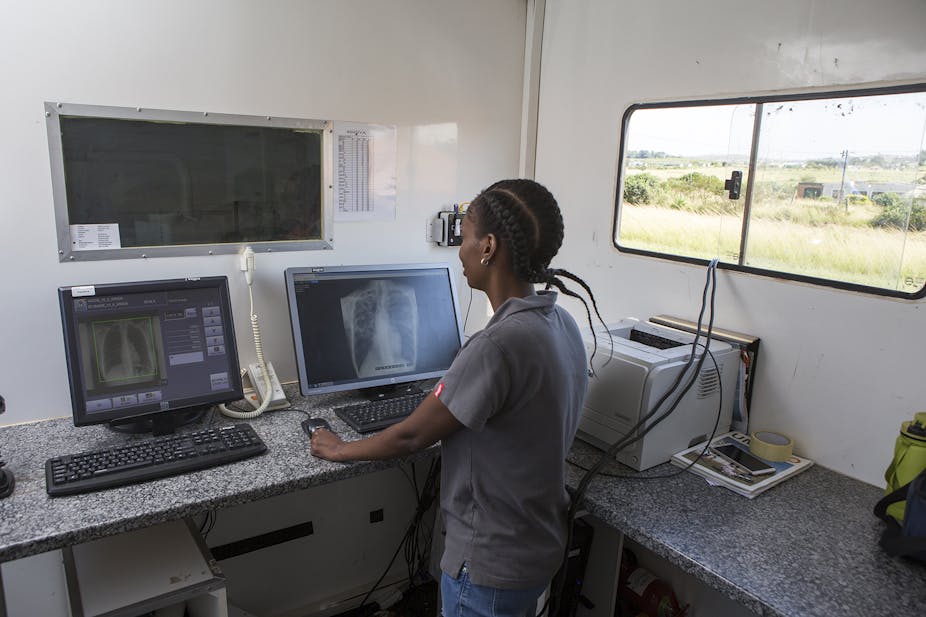South Africa’s massive effort over the years to test and treat people for HIV has drastically improved public health. But in that process, other diseases that are highly prevalent may have been neglected.
The country has been reporting lower rates HIV-related deaths. But more South Africans are presenting with noncommunicable diseases such as diabetes and hypertension. And tuberculosis (TB) remains the leading cause of death in people living with HIV.
We recently published the findings of research we did in a rural area of northern KwaZulu-Natal, South Africa. It aimed to get a clearer picture of the state of health and disease in the area and to identify the prevalence and overlap of infectious and noncommunicable diseases.
The ultimate goal is to design better interventions to improve people’s health.
We set up mobile health camps and screened for diabetes, high blood pressure, HIV, TB, nutritional status (obesity and malnutrition), and use of tobacco and alcohol.
The detailed data allowed us to develop a profile of which diseases were being well managed, and which neglected, in the community. For example, we found that HIV was well treated relative to all other diseases. But TB, elevated blood glucose, and elevated blood pressure were poorly diagnosed and treated.
The study also allowed us to identify overlaps between disease patterns and their geographical location. For example, it was very interesting to see that the areas with the highest prevalence of TB and noncommunicable diseases were mostly in the remote parts of the district and did not overlap with those with the highest rates of HIV.
Our findings raise important questions about how healthcare and screening can most effectively be offered in rural and remote areas. One of our conclusions was that South Africa needs a public health response that expands the successes of the country’s HIV testing and treatment programme to provide multi-disease care targeted to specific populations.
Key findings
Our study drew on data collected over 18 months from 2018 to 2019 in uMkhanyakude district, a remote rural area in the east of the country. We screened 17,118 people aged 15 years and older by taking mobile camps into the community and providing screening within 1 km of each participant’s home.
The study provides an in-depth snapshot of the health of a rural population in South Africa.
It shows that:
there are high and overlapping burdens of HIV, TB, diabetes and hypertension among men and women,
four out of five women over the age of 30 are living with a chronic health condition,
HIV-negative people and older people, particularly those over 50, bear a high burden of undiagnosed or poorly controlled noncommunicable diseases such as diabetes and hypertension.
We found the highest burden of HIV in the vicinity of the main roads. This is similar to other studies and has been observed throughout the region and world.
Just over half of all people 15 years or older (52%) were found to have at least one active disease, while 12% had two or more diseases. Over a third (34%) of people were living with HIV. This number was particularly high among 25 to 44-year-old women. The prevalence of HIV among them was 62%.
We attempted to measure the level of virus in every HIV-positive participant’s blood and found that 78% had no detectable virus, meaning that their antiretroviral therapy was working very well.
But the study also revealed that there are some demographic groups, including men in their 20s and 30s, who still have high rates of undiagnosed and untreated HIV and therefore have virus circulating in their blood. This means that they can pass HIV on to others. Our study highlights the importance of preventing new HIV infections, especially among young people.
In contrast to HIV, we found that most people with TB, diabetes or hypertension had disease which was previously undiagnosed or not well controlled. We found that 1.4% of the population had active TB, which is a very high rate in national and global context. Of these only 30% were already diagnosed and on medication for TB. This meant that approximately 1 in 100 people in this community had undiagnosed TB.
Despite being a curable disease, TB remains one of the leading causes of death in South Africa. We found higher rates of TB in men with just under half of all men over age 45 having had TB in his lifetime. The high rates of undiagnosed TB and the finding that men in particular are affected by TB are echoed in South Africa’s recent national TB prevalence survey and are a huge cause for concern.
Read more: First ever national survey shows the extent of South Africa's TB problem
We found that 8.5% of the population had high blood sugar (diabetes) and 23% had high blood pressure (hypertension). These conditions were mostly found in people older than 45 and were not well diagnosed or controlled.
Only 43% of people with high blood pressure and only 7% with high blood sugar had these conditions well controlled with medications. Women in particular bore a particularly high burden of disease with over 4 of 5 (80%) of those over 30 years old having at least one of these conditions.
When we asked participants about their experience in the study, they told us that they appreciated not having to travel long distances to receive screening.
Next steps
The data provide indicators for where the most urgent interventions are needed. It sets the stage for researchers to examine the biological, social and environmental determinants of disease in the area. It also provides detailed information to guide the Department of Health in development of decentralised models of rural healthcare that integrate management of HIV, TB and noncommunicable diseases.
This work has highlighted the immense burden of undiagnosed or untreated diabetes and hypertension in rural South Africa. As the country faces another surge of COVID-19, it is more important than ever to identify and treat people living with these diseases.

